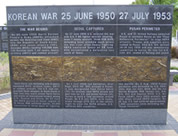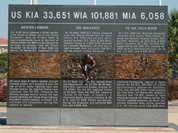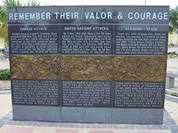The War Begins

On 25 June 1950, the North Korean People’s Army (NKPA) attacked across the Demilitarized
Zone (DMZ) into the
Republic of South Korea (ROK) with seven infantry divisions totaling
150,000 men, 150 Russian built T-34 tanks, heavy artillery and combat aircraft.
South Korea was defending with eight poorly equipped divisions without tanks, heavy
artillery or combat aircraft. The United States had not provided these weapons to
South Korea in fear that they would attack
North Korea and create an international incident among the U.S., Russia and
China. On 27 June 1950, the NKPA arrived at Seoul, capital of South Korea.
ROK suffered approximately 34,000 casualties in three days of fighting.
Seoul Captured
On 27 June 1950, the United States entered the war with U.S.
F-80 fighter aircraft shooting down seven enemy aircraft. Three ROK divisions
defending Seoul withdrew South across the
Han River after heavy fighting. NKPA captured Seoul on 28 June. ROK established
a defensive line South of Seoul.
On 1 July 1950, 1st Battalion, 21st Regiment, 24th
Infantry Division arrived in
Pusan, Korea. It was designated
Task Force Smith. Its’ mission: slow NKPA attack and gain time for the
U.S. and
United Nations forces to build a final perimeter around Pusan. On 5-6 July,
NKPA with tanks broke through the 24th Infantry Division. In the valiant
fight to slow the NKPA attack, the U.S. suffered 66% casualties.
Pusan Perimeter
U.S. and 21 United Nations selected Pusan in Southern Korea as the “Final Defensive
Perimeter” to stop NKPA attacks. Troops and supplies were rushed to Pusan. The U.S.
25th Infantry Division arrived 10-18 July 1950 and was immediately committed
to battle. On July 1st, the U.S. 1st Cavalry Division landed
at Pohang
and joined the battle. By 4 August 1950, the Pusan perimeter was defended by the
U.S. 24th, 25th, 2nd, 1st Cavalry Divisions
and the 1st Marine Brigade. ROK forces: 1st, 3rd,
6th, 8th, and Capital Divisions. The U.S. Air Force aircraft,
U.S. Navy aircraft and U.S. Naval ships struck NKPA targets. By 30 August, the U.S.
had suffered approximately 5,000 casualties while defending the “Pusan Perimeter”.
Inch’on Landing

United States and United Nations forces planned a daring coordinated attack to break
out of the “Pusan
Perimeter”. First on 15 September 1950 to land a waterborne force at the
Port of Inch’on behind the NKPA to be followed on 16 September by attacks from the
“Pusan Perimeter”. At 06:33am, 15 September, the 5th Marines, 1st
Marine Division supported by 230 UN Naval ships & fighter-bomber aircraft stormed
ashore on three beaches & over the top of 12 foot walls, fighting their way
through
Inch’on. By nightfall, Inch’on was captured. The 7th Infantry
Division following the Marines through Inch’on seized the high ground blocking the
Pusan-Seoul highway and NKPA reinforcements to Pusan. The U.S. suffered 173 casualties
during the capture of Inch’on.
The Breakout
On 16 September 1950, U.S. forces attacked from the “Pusan Perimeter” on three fronts:
U.S. 24th and 1st Cavalry Divisions toward Kunsan; U.S. 25th
and 2nd Divisions toward Kusan; & 6 ROK Divisions toward the Taebaek
Mountains. All units had to fight to reach their objectives. The 5th
Regimental Combat Team led the attack seizing Waegwan.
On 27 September, 1st Cavalry Division seized Osan and linked up with
the 7th Division. On 29 September, 25th Division captured
Kusan, freeing 97 U.S. Prisoners of War (POW). The 2nd Division captured
Chonju on 29 September. When the 24th Division captured Taejon on 28
September, it found 5-7 thousand South Korean civilians & 40 U.S. and 17 ROK
POWs murdered. During the breakout, the U.S. suffered 884 KIA and 3,868 WIA.
To the Yalu River
On 1 October 1950, General McArthur demanded surrender of North Korea. China stated,
“It would not tolerate invasion across the
38th parallel”. However, on that date, 2 ROK Divisions crossed
it. On 7 October, 1st Cavalry Division supported by the 24th
Division crossed the 38th parallel demilitarized zone. On 19 October,
1st Cavalry and 2 ROK Divisions captured Pyongyang, capital of North
Korea. On 20 October, 187th Regimental Combat Team of 2,800 paratroopers
jumped on Sunchon. 25th, 2nd and UNC Divisions raced towards
the
Yalu River. The 1st Marine Division landed at Wonsan and the
7th Division landed at Iwon attacking towards the Chinese border. The
7th Division reached Hysansin. On 26-27 October, the Chinese Volunteer
Army (CPVA) attacked U.S.-U.N. forces with 140,000 men.
Chinese Attack

40,000 Chinese People’s Volunteer Army (CPVA) soldiers attacked the ROK 6th,
7th, 8th and U.S. 1st Divisions on 27 October 1950
inflicting heavy casualties as the Divisions withdrew South. On 1 November, the
CPVA 50th & 60th Armies attacked the 1st Cavalry
& 2nd Divisions at Unsan inflicting 1,200 casualties. On 28 November,
200,000 CPVA crashed into 20,000 UN forces at the Chosin Reservoir.
The 1st Marine & 7th Divisons bore the brunt of the attack
as they fought their way through the bitter cold & rugged mountains to the Port
City of
Hungnam for evacuation by UN Naval forces. The U.S. suffered 2,500 KIA,
5,000 WIA & 3,500 cold injuries. On 1-4 January 1951, the CPVA of 500,000 men
seized Seoul despite the heroic fight of UN forces against the overwhelming troops
of the CPVA and NPKA.
United Nations Attacks
On 7 March 1951, UNC from a line 50 miles South of Seoul launched Operation “Ripper”
to retake Seoul & move North of the 38th parallel. The U.S. 1st
Cavalry, 2nd, 3rd, 7th, 24th, 25th,
1st Marines, ROK Divisions, USAF & USN aircraft and Naval ships captured
Seoul on 5 March 1951. On 23 March, 2,800 paratroopers of the 187th Regimental
Combat Team dropped on Munsan-ni and linked up with the 1st Cavalry Division.
In April and May 1951, the CPVA and NKPA launched two savage counter-attacks each
with 200,000 men in an attempt to recapture Seoul and stop the Northern advance
of UNC forces. Both sides suffered casualties. The fighting slowed as both sides
dug in along the DMZ. Estimated CPVA-NKPA casualties were 160,000.
Standoff – Peace
Peace talks began at Kaesong on 10 July 1951 & ended at Panmunjon on 27 July
1953 when the U.S., China and North Korea signed an “Armistice Agreement”.
U.S. casualties
- KIA 33,651
- WIA 101,881
- MIA 6,058
- POWs 7,246
Year 2005 – North Korean and South Korean Armies face each other at the DMZ.
Approximately 40,000 U.S. troops remain in South Korea.